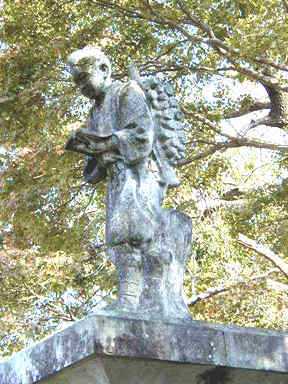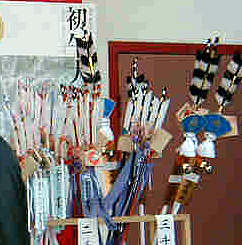Furusato: Yoko's Hometown
Kokoro No Furusato:
"A place dear to one's heart; one's spiritual home."
(Kenkyusha's New Japanese-English Dictionary, Fourth Edition)
Family Photos 2020


Above: YokoDana.com's Owner's Nephew's Family:
Note the twins in blue hifu (Hifu is a special hand-made vest for age 3 of Shichi-Go-San Celebration); Hifu Buttons are handmade using the same fabric. Flower buttons are Tsumami-zaiku crafted by Aunt Honami Nakashima, master level kimono-maker; Note also how the traditional and modern are blended together in all these family photos on this page.

Above: YokoDana.com's Owner's Niece's Family
Above: YokoDana.com's Owner's Niece's Oldest, Mana-chan, First Grade Picture
It is a time for the new school year in Japan. School starts in cherry blossom season, April every year. Yoko’s nieces girl Mana is ready For the 1st grade. She is wearing a kimono and hakama. The selection of this is very interesting: Traditional and modern are mixed very well. All the accessories are supplied by the studio. It is very common to get pictures taken professionally in Japan.This was taken by the Royal Photo Studio in Kumamoto Japan.

This rice field is near my home in Kumamoto prefecture. Each area, even by village, you see many different ways of stacking the rice hay in the fall, this is just one of many; Note the rows of buildings along the background. There are newer & older houses. These are rather typical type of rooftops inJapan; As land is so scarce in Japan, please note how close together the houses are.
These houses behind the rice field are public housing built by the local township for low-income families; This is a side of Japan not heard of often, but we have our poor & our homeless also. Here again, the old & the traditional sit aside the modern realities.

Kinjiro Ninomiya was born in 1787 during the Edo dynasty. He was famous as a person who studied and worked very hard. He was also known for his kindness. In his later years he rescued many of the Samurai families &
clans from financial difficulties & debts. He is also held in high regard among farmers as a figure who brought stability & quality of life through his endeavors as founder of Shinyou Kumiai First Savings & Trust.
This statue was for us a visible reminder of the values of hard work, study, loyalty & kindness to others. As I looked at this picture it brought back to me just how powerful these historical figures were to our moral development. Even now, my nieces & nephews play under the shadow of this statue today, and are taught about Kinjiro Ninomiya & the values he represents.

In my dictionary,Omikuji is translated, "A Written Oracle;sacred lot...."; Perhaps it might be also understood as a token of prayer for one's good luck, similar to lighting a candle in the Roman Catholic tradition.
Here we see a mother & her 2 sons visiting a local shrine in my village area; It looks like they have finished making a silent prayer, and the mother is putting the omikuji up with the many others; On the paper is the Chinese character un(the first character of unmei, which means, "destiny;fate; good/ill fortune...."; These little papers are provided by the Shrine & come in small bamboo tubes; After you read it, you tie it around the tree in the Shrine garden, or, as in this picture -- and moreso in recent years -- onto a special stand that is provided for supplicants to hang these.
It is a special sight to see some shrines with all the trees on the grounds filled with these white papers, blowing in the wind; There is a rustling sound like no other. For some people this sight & sound adds even more to the sense of the shrine being a sacred place.

Since I was a child, every summer during Obon we would go to the nearby town of Yamaga, a couple kilometers from my village, for the Yamaga Toro Matsuri, the Yamaga Lantern Festival. Legend has it that long ago an Emperor was travelling to Yamaga (a rare event in Feudal Japan) and due to a severe fog was unable to find his way, so the peasant women of Yamaga brought lanterns out by the hundreds to light his way. The festival is quite something to see, where 1000 young women dress in yukata (cotton summer kimonos) and wear specially crafted paper lanterns worn on the head. There is a central stage high above the crowd where a few young women lead the dance of 1000 lantern-bearing women with lit head dress in a dance in circles around the stage, accompanied by folk singing and instruments.
A few years ago my sister Fumi's daugher Ai was chosen as a lead dancer for the center stage and featured in the posters and literature advertising that year's Toro Matsuri. I came across these pictures the other day , which I didn't know I had, so wanted to share them here as it is a point of pride for us.
To learn more about this wonderful Kumamoto-prefecture festival you can find numerous resources in a google search of 'Yamaga Toro Matsuri'.
There is a collection of many pictures from this festival on Google HERE.



This small shrine is unattended. It is located a brief stroll from my house. Note the wooden torii (gates) which lead the way to the small shrine. The color is shuiro an orange-red (sometimes called vermillion. This color is traditionally believed to protect from evil spirits. (You may recall so many wedding kimono are in that color).The small wooden box in front of the shrine is for people to put their offerings into when they visit & pray. The rope attached to a large round bell is there for the supplicants also. This bell is rung in Shinto belief before they actually say their prayer; They usually swing the rope, bow & clap hands together twice.
NEW YEAR'S IN RURAL JAPAN
These pictures were taken in the area surrounding my home in Kyushu, Japan around New Years Day.





Above: Street Shrine for Deceased Child


Above: Kumamoto Castle Store Selling New Years Items
 Above: Village Store Selling New Years Items
Above: Village Store Selling New Years Items

Above: Shi-Shi Lion Statue Along Village Street

